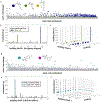DNA Barcoding a Complete Matrix of Stereoisomeric Small Molecules
- PMID: 31184885
- PMCID: PMC6681660
- DOI: 10.1021/jacs.9b01203
DNA Barcoding a Complete Matrix of Stereoisomeric Small Molecules
Abstract
It is challenging to incorporate stereochemical diversity and topographic complexity into DNA-encoded libraries (DELs) because DEL syntheses cannot fully exploit the capabilities of modern synthetic organic chemistry. Here, we describe the design, construction, and validation of DOS-DEL-1, a library of 107 616 DNA-barcoded chiral 2,3-disubsituted azetidines and pyrrolidines. We used stereospecific C-H arylation chemistry to furnish complex scaffolds primed for DEL synthesis, and we developed an improved on-DNA Suzuki reaction to maximize library quality. We then studied both the structural diversity of the library and the physicochemical properties of individual compounds using Tanimoto multifusion similarity analysis, among other techniques. These analyses revealed not only that most DOS-DEL-1 members have "drug-like" properties, but also that the library more closely resembles compound collections derived from diversity synthesis than those from other sources (e.g., commercial vendors). Finally, we performed validation screens against horseradish peroxidase and carbonic anhydrase IX, and we developed a novel, Poisson-based statistical framework to analyze the results. A set of assay positives were successfully translated into potent carbonic anhydrase inhibitors (IC50 = 20.1-68.7 nM), which confirmed the success of the synthesis and screening procedures. These results establish a strategy to synthesize DELs with scaffold-based stereochemical diversity and complexity that does not require the development of novel DNA-compatible chemistry.
Figures






Similar articles
-
Selection of Carbonic Anhydrase IX Inhibitors from One Million DNA-Encoded Compounds.ACS Chem Biol. 2011 Apr 15;6(4):336-44. doi: 10.1021/cb1003477. Epub 2011 Jan 12. ACS Chem Biol. 2011. PMID: 21186831
-
On-DNA hit validation methodologies for ligands identified from DNA-encoded chemical libraries.Biochem Biophys Res Commun. 2020 Dec 3;533(2):235-240. doi: 10.1016/j.bbrc.2020.04.030. Epub 2020 Apr 30. Biochem Biophys Res Commun. 2020. PMID: 32362331
-
Diversity-oriented synthesis encoded by deoxyoligonucleotides.Nat Commun. 2023 Aug 15;14(1):4930. doi: 10.1038/s41467-023-40575-5. Nat Commun. 2023. PMID: 37582753 Free PMC article.
-
Diversity-oriented synthesis as a tool to expand the chemical space of DNA-encoded libraries.Bioorg Med Chem. 2021 Jul 1;41:116218. doi: 10.1016/j.bmc.2021.116218. Epub 2021 May 15. Bioorg Med Chem. 2021. PMID: 34030087 Review.
-
Recent achievements and current trajectories of diversity-oriented synthesis.Curr Opin Chem Biol. 2020 Jun;56:1-9. doi: 10.1016/j.cbpa.2019.08.008. Epub 2019 Oct 15. Curr Opin Chem Biol. 2020. PMID: 31622927 Review.
Cited by
-
Iterative Catalyst-Controlled Diastereoselective Matteson Homologations Enable the Selective Synthesis of Benzestrol Isomers.J Am Chem Soc. 2024 Nov 13;146(45):30771-30777. doi: 10.1021/jacs.4c12857. Epub 2024 Oct 31. J Am Chem Soc. 2024. PMID: 39481083
-
Targeting fusion oncoproteins in childhood cancers: challenges and future opportunities for developing therapeutics.J Natl Cancer Inst. 2024 Jul 1;116(7):1012-1018. doi: 10.1093/jnci/djae075. J Natl Cancer Inst. 2024. PMID: 38574391 Free PMC article.
-
Pseudonatural Products for Chemical Biology and Drug Discovery.J Med Chem. 2025 Jul 24;68(14):14137-14170. doi: 10.1021/acs.jmedchem.5c00643. Epub 2025 Jul 1. J Med Chem. 2025. PMID: 40591938 Free PMC article. Review.
-
DNA-Encoded Chemistry: Drug Discovery from a Few Good Reactions.Chem Rev. 2021 Jun 23;121(12):7155-7177. doi: 10.1021/acs.chemrev.0c00789. Epub 2020 Oct 12. Chem Rev. 2021. PMID: 33044817 Free PMC article. Review.
-
Diversified strategy for the synthesis of DNA-encoded oxindole libraries.Chem Sci. 2021 Jan 4;12(8):2841-2847. doi: 10.1039/d0sc06696f. Chem Sci. 2021. PMID: 34164048 Free PMC article.
References
-
- Garbaccio RM; Parmee ER The Impact of Chemical Probes in Drug Discovery: A Pharmaceutical Industry Perspective. Cell Chem. Biol 2016, 23 (1), 10–17. - PubMed
-
- Franzini RM; Neri D; Scheuermann J DNA-Encoded Chemical Libraries: Advancing beyond Conventional Small-Molecule Libraries. Acc. Chem. Res 2014, 47 (4), 1247–1255. - PubMed
-
- Yang H; Medeiros PF; Raha K; Elkins P; Lind KE; Lehr R; Adams ND; Burgess JL; Schmidt SJ; Knight SD; Auger KR; Schaber MD; Franklin GJ; Ding Y; DeLorey JL; Centrella PA; Mataruse S; Skinner SR; Clark MA; Cuozzo JW; Evindar G Discovery of a Potent Class of PI3Kα Inhibitors with Unique Binding Mode via Encoded Library Technology (ELT). ACS Med. Chem. Lett 2015, 6 (5), 531–536. - PMC - PubMed
-
- Gilmartin AG; Faitg TH; Richter M; Groy A; Seefeld MA; Darcy MG; Peng X; Federowicz K; Yang J; Zhang S-Y; Minthorn E; Jaworski J-P; Schaber M; Martens S; McNulty DE; Sinnamon RH; Zhang H; Kirkpatrick RB; Nevins N; Cui G; Pietrak B; Diaz E; Jones A; Brandt M; Schwartz B; Heerding DA; Kumar R Allosteric Wip1 Phosphatase Inhibition through Flap-Subdomain Interaction. Nat. Chem. Biol 2014, 10, 181. - PubMed
Publication types
MeSH terms
Substances
Grants and funding
LinkOut - more resources
Full Text Sources
Other Literature Sources

